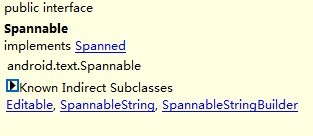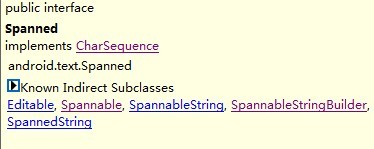有时候需要对文本进行各种特别的设置,比如颜色、大小、首行缩进,或者是在一段文本中加入图片,甚至是书写一些特殊的公式。如果通过布局文件使用多个控件来 实现,一方面会使的使用起来特别的复杂,增加了布局文件维护的难度,另一方面,如果加入了太多的控件,在页面加载时也要耗费更多的资源。如果在HTML 中,则可以使用各种标签来实现这些特殊效果,而在android中有类似的机制,只不过不是使用标签来实现,而是使用Spannable对象来实现。
一、关于Spannable的构建:
可以看出,Spannable继承自Spanned接口,而实际上,Spanned继承自CharSequence接口:
在TextView的 setText(CharSequence text)方法中,要求的参数正好是一个CharSequence对象,因此,我们可以通过Spannable对象来直接使用setText来完成文本的 设置。在使用中通常使用Spannable spn = new SpannableString("字符串");或者通过SpannableStringBuilder对象来进行构建。
二、给Spannable对象设置样式: 在构建除了Spannable 对象以后,就可以使用spannable.setSpan(Obj what, int start, int end, int flags)方法来进行样式的设置了,其中参数what是具体样式的实现对象,start则是该样式开始的位置,end对应的是样式结束的位置,参数 flags,定义在Spannable中的常量,常用的有:
Spanned.SPAN_EXCLUSIVE_EXCLUSIVE --- 不包含两端start和end所在的端点 (a,b) Spanned.SPAN_EXCLUSIVE_INCLUSIVE --- 不包含端start,但包含end所在的端点 (a,b] Spanned.SPAN_INCLUSIVE_EXCLUSIVE --- 包含两端start,但不包含end所在的端点 [a,b) Spanned.SPAN_INCLUSIVE_INCLUSIVE--- 包含两端start和end所在的端点 [a,b]
但实际测试这其中似乎并未有差别,而在start和end相同的情况下,则只对start所在字符的当前行起作用。
三、样式分析: 用来构建样式的具体的类都在android.text.style包下,下面逐一进行分析。
1.AbsoluteSizeSpan 顾名思义,AbsoluteSizeSpan是指绝对尺寸,通过指定绝对尺寸来改变文本的字体大小。该类有三个构造函数: AbsoluteSizeSpan(int size)、AbsoluteSizeSpan(int size, boolean dip)、AbsoluteSizeSpan(Parcel src)。 AbsoluteSizeSpan(int size):参数size, 以size的指定的像素值来设定文本大小。 AbsoluteSizeSpan(int size, boolean dip):参数size,以size的指定像素值来设定文本大小,如果参数dip为true则以size指定的dip为值来设定文本大小。 AbsoluteSizeSpan(Parcel src):参数src,包含有size和dip值的包装类。在该构造中
6.ForegroundColorSpan ForegroundColorSpan,字体颜色样式,用于改变字体颜色。该类有两个构造函数:ForegroundColorSpan(int color)、ForegroundColorSpan(Parcel src)。 ForegroundColorSpan(int color):参数color,字体颜色。 ForegroundColorSpan(Parcel src):参数src,包含字体颜色信息的包装类,使用如下:
8.ImageSpan ImageSpan,图片样式,主要用于在文本中插入图片。本类构造函数较多,但主要是针对Bitmap和Drawable的,也可以通过资源Id直接加载图片。如下: ImageSpan(Bitmap b):.参数b,用于显示的Bitmap。该方法已过时,改用Use ImageSpan(Context, Bitmap)代替。 ImageSpan(Bitmap b, int verticalAlignment):参数b,用于显示的Bitmap,参数verticalAlignment,对齐方式,对应ImageSpan中 的常量值。该方法已过时,改用ImageSpan(Context, Bitmap, int)代替。 ImageSpan(Context context, Bitmap b):参数context,传入的上下文,参数b,用于显示的Bitmap。 ImageSpan(Context context, Bitmap b, int verticalAlignment):参数context,传入的上下文,参数b,用于显示的Bitmap,参数verticalAlignment,对齐方式。 ImageSpan(Drawable d):参数d,用于显示的Drawable,此Drawable须设置大小。 ImageSpan(Drawable d, int verticalAlignment):参数d,用于显示的Drawable,参数verticalAlignment,对齐方式。 ImageSpan(Drawable d, String source):参数d,用于显示的Drawable,参数source,资源字符串。 ImageSpan(Drawable d, String source, int verticalAlignment):参数d,用于显示的Drawable,参数source,资源字符串,参数verticalAlignment,对齐方式。 ImageSpan(Context context, Uri uri):参数context,传入的上下文,参数uri,图片的uri。 ImageSpan(Context context, Uri uri, int verticalAlignment):参数context,传入的上下文,参数uri,图片的uri,参数verticalAlignment,对齐方式。 ImageSpan(Context context, int resourceId):参数context,传入的上下文,参数resourceId,图片的资源id。 ImageSpan(Context context, int resourceId, int verticalAlignment)参数context,传入的上下文,参数resourceId,图片的资源id,参数verticalAlignment,对齐方式。
9.LeadingMarginSpan LeadingMarginSpan.Standard,文本缩进的样式。有3个构造函数,分别为: Standard(int arg0):参数arg0,缩进的像素。 Standard(int arg0, int arg1):参数arg0,首行缩进的像素,arg1,剩余行缩进的像素。 Standard(Parcel p): 参数p,包含缩进信息的包装类。在构造时,
11.QuoteSpan QuoteSpan,引用样式,在文本左侧添加一条表示引用的竖线,该类有3个构造函数: QuoteSpan():无参构造,默认颜色为蓝色。 QuoteSpan(int color):参数color,颜色值。 QuoteSpan(Parcel src):包含颜色值信息的包装类。使用:
13.RelativeSizeSpan RelativeSizeSpan,相对大小,指相对于文本设定的大小的相对比例,如果没有设定则采用系统默认值。该类有两个构造函数: RelativeSizeSpan(float proportion):参数proportion,比例值。如果文字设定大小为A,则显示出来的大小为A×proportion。 RelativeSizeSpan(Parcel src):参数src,包含了比例值信息的包装类。使用:
16.StyleSpan StyleSpan,主要由正常、粗体、斜体和同时加粗倾斜四种样式,常量值定义在Typeface类中。构造函数: StyleSpan(int style):参数style,定义在Typeface中的常量。 StyleSpan(Parcel src):参数src,包含字体信息的包装类,用法:
18.SuperscriptSpan SuperscriptSpan,上标样式,比如数学上的次方运算,当然,还可以对上标文字进行缩放。构造函数: SuperscriptSpan():无参构造。 SuperscriptSpan(Parcel src):一参构造,参数src并未起任何作用,源码中为:
20.TextAppearanceSpan TextAppearanceSpan,使用style文件来定义文本样式,该类有4个构造函数: TextAppearanceSpan(Context context, int appearance):参数context,传入的上下文,参数appearance,引用的样式表,如R.style.my_style。 TextAppearanceSpan(Context context, int appearance, int colorList):参数context,使用的上下文,参数appearance,引用的样式表,如R.style.my_style,参数 colorList,使用方式未知,如果设置为小于0,则参数将不产生效果。 TextAppearanceSpan(String family, int style, int size,ColorStateList color, ColorStateList linkColor):参数family,字体,仅支持系统自带的三种字体,MONOSPACE、SERIF和SANS,参数 style,TypeFace中定义的字体样式,BOLD、ITALIC等,参数size,字体大小,参数color,字体颜色,参数 linkColor,使用方式未知。TextAppearanceSpan(Parcel src):参数src,含有样式信息的包装类,样式信息参照5参构造。使用:
21.TypefaceSpan TypefaceSpan,字体样式,可以设置不同的字体,比如系统自带的SANS_SERIF、MONOSPACE和SERIF。构造函数: TypefaceSpan(String family):参数family,字体的值,以字符串表示。 TypefaceSpan(Parcel src): 参数src,包含字体family信息的包装类,使用如下:
UnderlineSpan,下划线样式,给一段文字加上下划线。构造函数: UnderlineSpan(): 无参构造。 UnderlineSpan(Parcel src):一参构造, 与无参构造效果相同,构造中未对src做处理。源码:
下载地址:点击下载
一、关于Spannable的构建:

可以看出,Spannable继承自Spanned接口,而实际上,Spanned继承自CharSequence接口:

在TextView的 setText(CharSequence text)方法中,要求的参数正好是一个CharSequence对象,因此,我们可以通过Spannable对象来直接使用setText来完成文本的 设置。在使用中通常使用Spannable spn = new SpannableString("字符串");或者通过SpannableStringBuilder对象来进行构建。
二、给Spannable对象设置样式: 在构建除了Spannable 对象以后,就可以使用spannable.setSpan(Obj what, int start, int end, int flags)方法来进行样式的设置了,其中参数what是具体样式的实现对象,start则是该样式开始的位置,end对应的是样式结束的位置,参数 flags,定义在Spannable中的常量,常用的有:
Spanned.SPAN_EXCLUSIVE_EXCLUSIVE --- 不包含两端start和end所在的端点 (a,b) Spanned.SPAN_EXCLUSIVE_INCLUSIVE --- 不包含端start,但包含end所在的端点 (a,b] Spanned.SPAN_INCLUSIVE_EXCLUSIVE --- 包含两端start,但不包含end所在的端点 [a,b) Spanned.SPAN_INCLUSIVE_INCLUSIVE--- 包含两端start和end所在的端点 [a,b]
但实际测试这其中似乎并未有差别,而在start和end相同的情况下,则只对start所在字符的当前行起作用。
三、样式分析: 用来构建样式的具体的类都在android.text.style包下,下面逐一进行分析。
1.AbsoluteSizeSpan 顾名思义,AbsoluteSizeSpan是指绝对尺寸,通过指定绝对尺寸来改变文本的字体大小。该类有三个构造函数: AbsoluteSizeSpan(int size)、AbsoluteSizeSpan(int size, boolean dip)、AbsoluteSizeSpan(Parcel src)。 AbsoluteSizeSpan(int size):参数size, 以size的指定的像素值来设定文本大小。 AbsoluteSizeSpan(int size, boolean dip):参数size,以size的指定像素值来设定文本大小,如果参数dip为true则以size指定的dip为值来设定文本大小。 AbsoluteSizeSpan(Parcel src):参数src,包含有size和dip值的包装类。在该构造中
public AbsoluteSizeSpan(Parcel src) {
mSize = src.readInt();
mDip = src.readInt() != 0;
} 使用范例: Parcel p = Parcel.obtain(); p.writeInt(29);//字体大小 p.writeInt(8);//是否是dip单位 p.setDataPosition(0); AbsoluteSizeSpan ass = new AbsoluteSizeSpan(p);2.AlignmentSpan.Standard AlignmentSpan.Standard, 标准文本对齐样式,该类有两个构造函数,AlignmentSpan.Standard(Layout.Alignment align)和AlignmentSpan.Standard(Parcel src)。AlignmentSpan.Standard(Layout.Alignment align):参数align,Layout.Alignment类型的枚举值。包括居中、正常和相反三种情况。 AlignmentSpan.Standard(Parcel src):参数src,包含有标准字符串的Parcel类,其值应为"ALIGN_CENTER"、"ALIGN_NORMAL" 或"ALIGN_OPPOSITE"中的之一,对应Layout.Alignment枚举中的三个类型。使用示例:
Parcel p = Parcel.obtain(); p.writeString(\"ALIGN_CENTER\"); p.setDataPosition(0); AlignmentSpan.Standard standard = new AlignmentSpan.Standard(p);3.BackgroundColorSpan BackgroundColorSpan,背景色样式,显然可以用来设定文本的背景色。该类有两个构造函数,BackgroundColorSpan(int color)和BackgroundColorSpan(Parcel src)。 BackgroundColorSpan(int color):参数color,颜色值。 BackgroundColorSpan(Parcel src):参数src,包含颜色值信息的包装类,使用方法如下:
Parcel p = Parcel.obtain(); p.writeInt(Color.GREEN); p.setDataPosition(0); BackgroundColorSpan bcs = new BackgroundColorSpan(p);4.BulletSpan BulletSpan, 着重样式,类似于HTML中的
- 标签的圆点效果。该类有4个构造函数BulletSpan()、BulletSpan(int gapWidth)、BulletSpan(int gapWidth,int color)、BulletSpan(Parcel src)。 BulletSpan():仅提供一个与文本颜色一致的符号。 BulletSpan(int gapWidth): 提供一个与文本颜色一致的符号,并指定符号与后面文字之间的空白长度。 BulletSpan(int gapWidth,int color):提供一个指定颜色的符号,并指定符号与后面文字之间的宽度。 BulletSpan(Parcel src):参数src,包含宽度、颜色信息的包装类,在以此构造时,构造函数的调用如下:
mGapWidth = src.readInt(); mWantColor = src.readInt() != 0; mColor = src.readInt();
如果使用Parcel作为参数时,使用方式为:Parcel p = Parcel.obtain(); p.writeInt(20);//设置gapWidth p.writeInt(1);//设置是否使用颜色 p.writeInt(Color.YELLOW);//设置颜色 p.setDataPosition(0); BulletSpan bs3 = new BulletSpan(p);
6.ForegroundColorSpan ForegroundColorSpan,字体颜色样式,用于改变字体颜色。该类有两个构造函数:ForegroundColorSpan(int color)、ForegroundColorSpan(Parcel src)。 ForegroundColorSpan(int color):参数color,字体颜色。 ForegroundColorSpan(Parcel src):参数src,包含字体颜色信息的包装类,使用如下:
Parcel p = Parcel.obtain(); p.writeInt(Color.YELLOW); p.setDataPosition(0); ForegroundColorSpan fcs = new ForegroundColorSpan(p);7.IconMarginSpan IconMarginSpan,图标+Margin样式,该类与DrawableMarginSpan使用上很相似。本类有两个构造函数: IconMarginSpan(Bitmap b):参数b,用于显示图像的bitmap。 IconMarginSpan(Bitmap b,int pad):参数b,用于显示图像的bitmap,参数pad,Bitmap和文本之间的间距。
8.ImageSpan ImageSpan,图片样式,主要用于在文本中插入图片。本类构造函数较多,但主要是针对Bitmap和Drawable的,也可以通过资源Id直接加载图片。如下: ImageSpan(Bitmap b):.参数b,用于显示的Bitmap。该方法已过时,改用Use ImageSpan(Context, Bitmap)代替。 ImageSpan(Bitmap b, int verticalAlignment):参数b,用于显示的Bitmap,参数verticalAlignment,对齐方式,对应ImageSpan中 的常量值。该方法已过时,改用ImageSpan(Context, Bitmap, int)代替。 ImageSpan(Context context, Bitmap b):参数context,传入的上下文,参数b,用于显示的Bitmap。 ImageSpan(Context context, Bitmap b, int verticalAlignment):参数context,传入的上下文,参数b,用于显示的Bitmap,参数verticalAlignment,对齐方式。 ImageSpan(Drawable d):参数d,用于显示的Drawable,此Drawable须设置大小。 ImageSpan(Drawable d, int verticalAlignment):参数d,用于显示的Drawable,参数verticalAlignment,对齐方式。 ImageSpan(Drawable d, String source):参数d,用于显示的Drawable,参数source,资源字符串。 ImageSpan(Drawable d, String source, int verticalAlignment):参数d,用于显示的Drawable,参数source,资源字符串,参数verticalAlignment,对齐方式。 ImageSpan(Context context, Uri uri):参数context,传入的上下文,参数uri,图片的uri。 ImageSpan(Context context, Uri uri, int verticalAlignment):参数context,传入的上下文,参数uri,图片的uri,参数verticalAlignment,对齐方式。 ImageSpan(Context context, int resourceId):参数context,传入的上下文,参数resourceId,图片的资源id。 ImageSpan(Context context, int resourceId, int verticalAlignment)参数context,传入的上下文,参数resourceId,图片的资源id,参数verticalAlignment,对齐方式。
9.LeadingMarginSpan LeadingMarginSpan.Standard,文本缩进的样式。有3个构造函数,分别为: Standard(int arg0):参数arg0,缩进的像素。 Standard(int arg0, int arg1):参数arg0,首行缩进的像素,arg1,剩余行缩进的像素。 Standard(Parcel p): 参数p,包含缩进信息的包装类。在构造时,
public Standard(Parcel src) {
mFirst = src.readInt();
mRest = src.readInt();
} 使用方式: Parcel p = Parcel.obtain(); p.writeInt(20); p.writeInt(30); p.setDataPosition(0); Standard lms = new Standard(p);10.MaskFilterSpan MaskFilterSpan,滤镜样式,只有一个构造函数: MaskFilterSpan(MaskFilter filter):参数filter,滤镜样式。 说明: 在android系统里,MaskFilter提供了两个子类,BlurMaskFilter和EmbossMaskFilter,分别用来制作模糊效果和浮雕效果。
11.QuoteSpan QuoteSpan,引用样式,在文本左侧添加一条表示引用的竖线,该类有3个构造函数: QuoteSpan():无参构造,默认颜色为蓝色。 QuoteSpan(int color):参数color,颜色值。 QuoteSpan(Parcel src):包含颜色值信息的包装类。使用:
Parcel p = Parcel.obtain(); p.writeInt(Color.BLACK); p.setDataPosition(0); QuoteSpan qs = new QuoteSpan(p);12.RasterizerSpan RasterizerSpan,字面义为光栅化,实际效果不明显,待完善。一个构造函数: RasterizerSpan(Rasterizer r):Rasterizer只有一个系统定义了的子类LayerRasterizer
13.RelativeSizeSpan RelativeSizeSpan,相对大小,指相对于文本设定的大小的相对比例,如果没有设定则采用系统默认值。该类有两个构造函数: RelativeSizeSpan(float proportion):参数proportion,比例值。如果文字设定大小为A,则显示出来的大小为A×proportion。 RelativeSizeSpan(Parcel src):参数src,包含了比例值信息的包装类。使用:
Parcel p = Parcel.obtain(); p.writeFloat(2.5f); p.setDataPosition(0); RelativeSizeSpan rss = new RelativeSizeSpan(p);14.ScaleXSpan ScaleXSpan,横向缩放样式,将字体按比例进行横向缩放。构造函数: ScaleXSpan(float proportion):参数proportion,缩放比例。如果字体设置的大小为A,则实际显示为A×proportion。 ScaleXSpan(Parcel src):参数src,包含了缩放比例信息的包装类。使用:
Parcel p = Parcel.obtain(); p.writeFloat(2.5f); p.setDataPosition(0); ScaleXSpan rss = new ScaleXSpan(p);15.StrikethroughSpan StrikethroughSpan,删除线样式。该类有两个构造函数: StrikethroughSpan()和SrickkethroughSapn(Parcel src)。但有参数的构造函数并未对src参数做处理, public StrikethroughSpan(Parcel src) { }
16.StyleSpan StyleSpan,主要由正常、粗体、斜体和同时加粗倾斜四种样式,常量值定义在Typeface类中。构造函数: StyleSpan(int style):参数style,定义在Typeface中的常量。 StyleSpan(Parcel src):参数src,包含字体信息的包装类,用法:
Parcel p = Parcel.obtain(); p.writeInt(Typeface.BOLD_ITALIC); p.setDataPosition(0); StyleSpan ss = new StyleSpan(p);17.SubscriptSpan SubscriptSpan,脚注样式,比如化学式的常见写法,当然,还可以对脚注的文字做一定的缩放。构造函数: SubscriptSpan():无参构造。 SubscriptSpan(Parcel src):一参构造,参数src并未起任何作用,源码中为: public SuperscriptSpan(Parcel src) { }
18.SuperscriptSpan SuperscriptSpan,上标样式,比如数学上的次方运算,当然,还可以对上标文字进行缩放。构造函数: SuperscriptSpan():无参构造。 SuperscriptSpan(Parcel src):一参构造,参数src并未起任何作用,源码中为:
public SuperscriptSpan(Parcel src) {
} 19.TabStopSpan TabStopSpan.Standard,制表位偏移样式,距离每行的leading margin的偏移量,据测试在首行加入制表符时才产生效果。构造函数: TabStopSpan.Standard(int where):参数where,偏移量。20.TextAppearanceSpan TextAppearanceSpan,使用style文件来定义文本样式,该类有4个构造函数: TextAppearanceSpan(Context context, int appearance):参数context,传入的上下文,参数appearance,引用的样式表,如R.style.my_style。 TextAppearanceSpan(Context context, int appearance, int colorList):参数context,使用的上下文,参数appearance,引用的样式表,如R.style.my_style,参数 colorList,使用方式未知,如果设置为小于0,则参数将不产生效果。 TextAppearanceSpan(String family, int style, int size,ColorStateList color, ColorStateList linkColor):参数family,字体,仅支持系统自带的三种字体,MONOSPACE、SERIF和SANS,参数 style,TypeFace中定义的字体样式,BOLD、ITALIC等,参数size,字体大小,参数color,字体颜色,参数 linkColor,使用方式未知。TextAppearanceSpan(Parcel src):参数src,含有样式信息的包装类,样式信息参照5参构造。使用:
Parcel p = Parcel.obtain();
p.writeString(\"SERIF\");
p.writeInt(Typeface.BOLD_ITALIC);
p.writeInt(10);
try {
ColorStateList colorlist = ColorStateList.createFromXml(ctx.getResources(),ctx.getResources().getXml(R.drawable.parcelcolorlist));
p.writeInt(1);
colorlist.writeToParcel(p, Parcelable.PARCELABLE_WRITE_RETURN_VALUE);
p.writeInt(1);
colorlist.writeToParcel(p, Parcelable.PARCELABLE_WRITE_RETURN_VALUE);
} catch (Exception e) {
e.printStackTrace();
}
p.setDataPosition(0);
TextAppearanceSpan tas = new TextAppearanceSpan(p); 注:在这个设置中style似乎并未起到作用,另外关于这个类的colorList和linkColor参数的使用尚不明了,有待解答。21.TypefaceSpan TypefaceSpan,字体样式,可以设置不同的字体,比如系统自带的SANS_SERIF、MONOSPACE和SERIF。构造函数: TypefaceSpan(String family):参数family,字体的值,以字符串表示。 TypefaceSpan(Parcel src): 参数src,包含字体family信息的包装类,使用如下:
Parcel p = Parcel.obtain(); p.writeString(\"SERIF\"); p.setDataPosition(0); TypefaceSpan ts = new TypefaceSpan(p);22.UnderlineSpan
UnderlineSpan,下划线样式,给一段文字加上下划线。构造函数: UnderlineSpan(): 无参构造。 UnderlineSpan(Parcel src):一参构造, 与无参构造效果相同,构造中未对src做处理。源码:
public UnderlineSpan(Parcel src) {
} 23.URLSpan URLSpan,可以打开一个链接。两个构造函数: URLSpan(String url):参数url,链接地址。 URLSpan(Parcel src):参数src,包含链接地址信息的包装类,使用如下: Parcel p = Parcel.obtain();
p.writeString("http://www.sina.com.cn");
p.setDataPosition(0);
URLSpan us = new URLSpan(p); 下载地址:点击下载
收藏的用户(0) X
正在加载信息~
推荐阅读
最新回复 (1)
-
 QQD422BF4D505803C5392151408FE4AE 2015-2-13引用 2楼Wow that was strange. I just wrote an extremely long comment but after I clicked submit my comment didn't show up. Grrrr... well I'm not writing all that over again. Anyhow, just wanted to say excellent blog! cheap louis vuitton http://www.nsbenycalumni.org
QQD422BF4D505803C5392151408FE4AE 2015-2-13引用 2楼Wow that was strange. I just wrote an extremely long comment but after I clicked submit my comment didn't show up. Grrrr... well I'm not writing all that over again. Anyhow, just wanted to say excellent blog! cheap louis vuitton http://www.nsbenycalumni.org
站点信息
- 文章2306
- 用户1336
- 访客11533321
每日一句
You had me at hello; it was love at first sight. — Friends
你一开口我就沦陷了;那是爱情的初见。—《老友记》
你一开口我就沦陷了;那是爱情的初见。—《老友记》
 阿里云再次搬迁笔记
阿里云再次搬迁笔记 利用Internet Download Manager下载Google云盘大文件
利用Internet Download Manager下载Google云盘大文件 Linux查看进程及相关操作常用命令
Linux查看进程及相关操作常用命令 5G:无线网络的未来?
5G:无线网络的未来? 免费xiuno博客主题【最后更新:2019.5.20】
免费xiuno博客主题【最后更新:2019.5.20】 Run-Time Check Failure #0 - The value of ESP was not properly saved across a function call. This is
Run-Time Check Failure #0 - The value of ESP was not properly saved across a function call. This is IDEA创建SpringBoot项目详细步骤
IDEA创建SpringBoot项目详细步骤 C++实现NAT检测程序
C++实现NAT检测程序 easypoi快捷表格框架使用
easypoi快捷表格框架使用 Xposed框架的使用
Xposed框架的使用 安卓准备向手机厂商收费?
安卓准备向手机厂商收费? 解决SSH连接问题packet too long 1349676920
解决SSH连接问题packet too long 1349676920 Android 8.0应用图标适配
Android 8.0应用图标适配
新会员